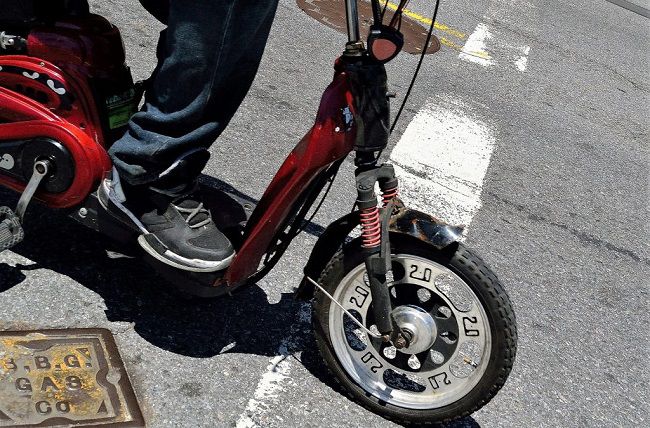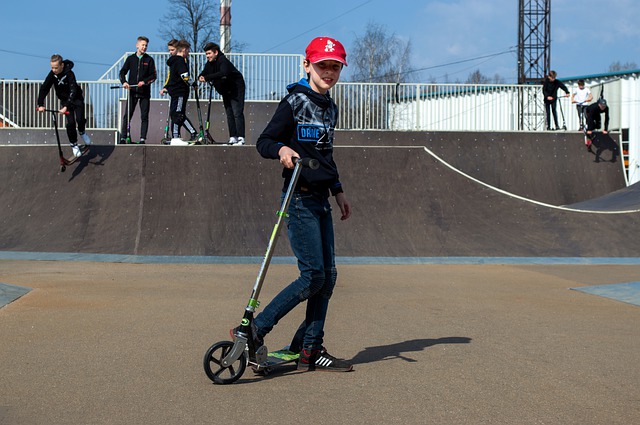When choosing a personal electric vehicle like a scooter or a bike to make an educated decision you need to consider three main factors – the electric motor, the batteries and the brakes. In this article, I will cover the basics you need to know so you can choose the best scooter or e-bike.
We have articles with comparions of the best sccoter brands here: electric scooters for adults and scooters for kids.
The electric motor
The two important features of an EV motor are its power and how is the heat of the motor managed.
The electric motor power
The power rating of an electric motor is determined by its operating voltage (volts) and on its current handling capacity (amps) at that operating voltage. The unit of measure is the ‘watt’.
Usually, an electric motor can handle significantly more power (watts) for a short period of time versus operating continuously.
The amount of power a motor can handle for a short period of time (seconds or minutes) is called ‘peak’ power and the amount of power the motor can handle continuously (hours – days) is called ‘continuous’ power.
The continuous power rating is the rating most useful for electric scooter/bike applications.
The higher the wattage of the motor the higher the voltage or current has to be.
The device that must supply the motor with all the voltage and current it needs (watts) is the battery.
A motor powered by a battery has a capacity limited to the power capacity (voltage x current output per hour ‘ah’ ampere hour) of the battery.
An electric motor is an electro-mechanical device that by design is limited to the amount of current (amps) it can draw (internal resistance). The amount of voltage it can handle can be exceeded, leading to component breakdown and the destruction of the motor.
The input power of a motor is simply the amount of wattage it takes to operate.
The output power of a motor is the amount of wattage the motor offers towards doing work.
The ratio of input power to output power is called the efficiency of the motor. One obviously hopes to get as much power out of a motor as ones put into a motor, but there are no 100% efficient motors. The higher the efficiency the better.
The power lost between input power and output power turns up as heat. Heat is an enemy to all motors and can lead to breakdown if not kept within safe limits.
If a motor can be cooled effectively its power rating can be pushed above normal operating limits.
Watts explained
Power for electric scooters is usually measured in ‘watts’, whereas it is usually measured in horsepower for petrol scooters.
One horsepower equals 746 watts.
Most small electric scooters have less than 746-watt motors.
Electric scooter motors and controllers handle power differently for continuous riding versus short-term ‘peak’ riding moments.
A scooter motors ‘continuous power’ rating it the one that should govern ones purchasing decision. This means the motor is likely to put out the specified power during continuous riding, which is ‘normal’ electric scooter operation.
A scooters motors ‘peak’ power rating may be much higher and make the scooter look attractive. The peak rating, however, is the power that the motor can handle for only seconds/minutes and may lead to over-heating and motor failure if the peak is approached too often or in warm weather.
Beware of cheap scooter peddlers that claim ‘high’ wattage specification for what appear to be standard ‘clone’ models.
The more watts your motor can handle the better buffer you have for expecting ‘cool running’ and long-term reliability if you operate your vehicle in a conservative manner.
The motor controller is an integral part of an electric scooter’s power handling capabilities. No matter how powerful the motor is (watts capability) it will perform at no greater level than what the controller allows. No matter how powerful the controller is that is connected to an electric motor, the motor will not perform greater than it’s designed parameters unless the voltage is raised passed it’s designed parameters, in which case failure may result.
The range of an electric scooter is determined by how many watts are required to complete the journey.
Watts can be measured by multiplying the battery voltage by the amount of current (amps) that are required to do the work. The harder the work … heavy rider/scooter, fast speeds, hill climbing, many stops and starts.. the more amps that are used, therefore, the more watts used or required.
Beware of scooter range claims that go against the law of physics; meaning, their batteries are too small to possibly achieve the range claims that are made, except downhill or over a cliff!
The latest ‘upper end’ clones have 36v 12ah battery packs. That means that the battery can put out a ‘maximum’ of 36 x 12 = 432 watts for one hour (That would meaning draining every drop of power, so the ‘actual’ capability is less).
It takes hundreds to thousands of watt s to push an electric scooter with a 180 lb rider over at flat road at 20, 30, 40+ mph. When you add in what it takes for a second or two to get started from each stop (up to a thousand watts or more), the even higher wattage required to climb hills, especially at high speed, then you will see that the clones claims of 20 mph speeds and 20-30 mile range is ridiculous.
If you can afford it, get a scooter that exceeds your needs rather than meets your needs, like the one that meets your needs is probably being run near the ‘red line’.
The electric motor heat (keep it cool)
Heat is the enemy of electric motors and motor controllers.
The failure of most electric scooter makers to handle the heat build-up on motor controllers and motors is perhaps the single most limiting factor in electric scooter use.
You can’t ride current electric scooter designs like an equivalent powered petrol scooter, because the current electric scooters rely on radiation cooling (the motor radiates the heat into the air) with a ‘few’ having some sort of heatsinking enhancement. Only the cheapest of possible petrol powered engines rely solely on the passive cooling of the motor by the surrounding air. Most petrol power scooters have a built-in fan or a fluid reservoir system that cools the motor.
Petrol engines have metals/materials that make up the cylinder(s) that can withstand extremely high temperatures and only need to have excess heat transferred away by fluid or air-cooling methods. The electric motor uses electric current and magnetic fields to generate power. The heat that is generated must radiate from the active parts via the motor casing to the surrounding air unless there are holes in the casing to allow for direct radiation. Most electric scooter motors are ‘sealed’ (no holes) to avoid dirt and water from corroding the inner workings.
Electric scooter motors usually are mounted behind the battery box and therefore don’t benefit very much from the air current movement when in motion. Motors that are too hot to touch after a long ride or steep hill climb are probably at risk of early failure if they are constantly run that way.
Motor controllers (often called PWM) pass all of the current that goes to the motor and therefore are also subject to excessive heat. The controllers are made of electronic components that are a lot less tolerant of excessive heat than the motor. The controller’s power handling components usually radiate excess heat via a ‘heat sink’ that is further enhanced by being attached to the metal casing.
A heat sink is usually made out of metals or ceramics that transfer heat rapidly. They are usually shaped in fin configurations for more effective radiation.
Operating a motor controller or motor at a higher voltage than it was designed or for a longer duty cycle (on-off) will create excess heat. The controller also might fail if ‘any’ of the electronic components inside are not able to handle the increased voltage.
Any sort of air-cooling of either the controller or motor will increase life/reliability, but the motor really needs to be cooled from the inside, to be very effective. Blowing air across the fins of the controller’s heat sink is usually sufficient.
The most effective inexpensive way to cool an electric motor is via ‘forced air cooling’.
You create forced air-cooling of an electric motor by restricting air access to the motor and by providing ample air escape. The restricted air intake has air forced into it via a ‘blower’. The air travels through the internal workings of the motor pushing the hot air as it goes out the ample escape holes on the other side of the motor. Air comes in one side of the motor and is forced out on the other side.
A forced cooled motor can often be operated for a duty cycle many times longer than normal, or it often can be run at higher voltages for more power.
Most of the warranty issues concerning electric scooters are blown controller or motors. Electric scooter makers could save their profits if they built their scooter with effective cooling. It would be an extremely inexpensive thing to do, considering the alternatives.
Traditionally the motor expensive electric scooters makers have used bigger motors and controllers that can handle duty cycles and power needs several times higher than required. But These scooters, however, with their over-kill electric motors and controller may not handle the duty cycle loads of a petrol scooter costing much less. The consumer must pay through the nose for the couple that can.
Brakes
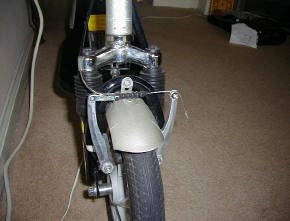 |
| V brake |
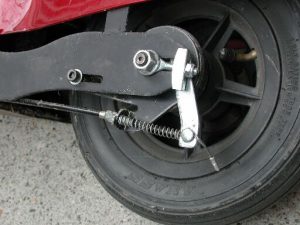 |
| Band brake |
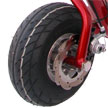 |
| Disk brake |
 |
| Drum brake |
…
The scooter should have dual brakes or a strong single disk brake for safety. Anything less is unsafe going down steep hills or during panic stops.
Bike ‘V’ brakes work better than most ‘band’ brakes.
A band brake is ‘not a drum brake’. It is not as strong or as durable.
Use both brakes when stopping (if applicable).
Because of the low centre of gravity for most scooters, front brakes can be applied rigorously without throwing the rider over the handlebar. One needs to be careful, however, when riding stand-up!!
Electric scooter brake pads do wear out just like those on cars and larger motorcycles/scooters. Keep good pads in your brakes!
Adjust your brakes for top performance at least once a week.
Batteries
Nickel Metal Hydride Batteries (NIMH)
 |
| 36v 13ah NiMH battery |
 |
| 24v 13ah NiMH battery |
 |
||
| 36v 9ah NiMH battery |
…
NiMH batteries are well established in the electronics market: cameras, portable devices, flashlights, etc. They are marginal in the electric scooter and electric bike markets because of their cost and the fact that they are not yet suitable for high current drain situations.
The Nimh packs required by electric vehicles are made by putting many smaller cells in series. This allows them to meet the voltage requirements. The current requirements require putting NiMH packs in parallel and that causes problems with charging.
If one has a large budget to build-in the proper intelligence to monitor individual NiMH cells in a pack and to take appropriate steps in the event of cell failure, then NiMH can be used successfully in electric vehicle applications.
Nimh packs are best for light current draw electric bikes and scooters, They typically weigh about 60% of the weight of equivalent lead acid types.
Lithium-Ion Batteries (Lion)
 |
| Li-on battery pack |
 |
| Yamaha Passol uses Li-on battery pack |
…
Ditto the above about Nimhs for Lions and add they cost, even more, are more finicky when trying to build multi-cell packs, and they can be dangerous under high current drain situations if the packs are not properly designed and constructed.
They are even lighter than Nimhs.
Sealed Lead Acid batteries (SLA)
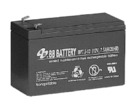 |
| 12v 8 ah Battery |
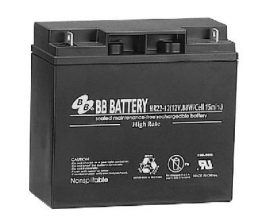 |
| 12v 50ah battery |
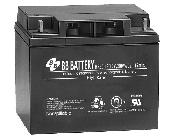 |
| 12v 22ah battery |
…
Sealed lead acid batteries are the cornerstone of the electric vehicle market, but they are also its greatest limiter for expanding performance. Sealed Lead Acid batteries (SLA) haven’t improved that much in a hundred years. They are heavy for the power they put out, and their recharge life is less than the Nimhs or Li-Ion chemistries.
SLA is like car batteries except there is no liquid acid to spill and corrode. They use a ‘paste’ and the unit is sealed with nothing other than the terminals exposed.
If you want reliability, simple charging, and power at a cheap price, they are the only game in town. They take up a lot of space, however, and one gets into ‘diminishing returns’ by adding more and more batteries for more range. The extra weight eventually negates the extra power gain.
And if you like doing stunts, then make sure to visit our top scooters for stunts selection.


